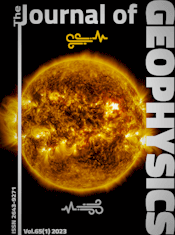Parameter trade-off in one-dimensional magnetotelluric modelling
Article Sidebar

Vols. 1-18 (1924-1944), ISSN 0044-2801
Main Article Content
Abstract
The problem of inverting or modelling one-dimensional magnetotelluric data can, today, be considered as largely resolved. Attention now focuses on the class of acceptable models. Viewed in the space of model parameters this class occupies a singly connected volume, bound with a surface where the standard deviation ε between measured and calculated response exceeds the minimum εo of the best-fitting model by a constant factor (typically ε ≈ 1.10 εo). This volume of acceptable models is described by its intersections with the parameter axes, and also by the extreme excursions possible for any of the model parameters when all the other parameters are adjusted accordingly. These extreme excursions therefore represent "trade-off" conditions among the model parameters and are summarized in the "trade-off matrix". In a sense this is a generalization of the parameter correlation matrix, which gives only local information in the vicinity of a proposed model. The trade-off matrix, however, is independent of any initial model. Another important question considered deals with the correct choice of the number of layers with which to model a data set. Whereas a single minimum of ε is found with the correct number no, when this number is too small the information contained in the data is spread among several isolated minima. When n > no the problem becomes "illposed ". There are too many degrees of freedom and it becomes possible, then, to move in model space in directions at right angles to the meaningful dimensions without finding a clear minimum. The problem is analogous to a vanishing determinant in linear algebra. To find a regular problem again it is necessary to specify auxiliary constraints provided, for example, by other soundings or prior geological knowledge, to compensate for the increased number of variables.
 ARK: https://n2t.net/ark:/88439/y061860
ARK: https://n2t.net/ark:/88439/y061860
Permalink: https://geophysicsjournal.com/article/289
Article Details
References
Eichler, K. (1980) Inversion eindimensionaler Magnetotellurik-Daten mit Hilfe eines Optimierungsverfahrens, Diploma thesis, Department of Geophysics, University of Munster, Germany
Fischer, G., Schnegg, P.-A., Peguiron, M., Le Quang, B.V. (1981) An analytic one-dimensional magnetotelluric inversion scheme. Geophys. J. R. Astron. Soc. 67:257-278
Fischer, G., Le Quang, B.V. (1981) Topography and minimization of the standard deviation in one-dimensional magnetotelluric modelling. Geophys. J. R. Astron. Soc. 67:279-292
Hobbs, B.A. (1977) The electrical conductivity of the Moon: an application of the inverse theory. Geophys. J. R. Astron. Soc. 51:727-744
Hobbs, B.A. (1982) Automatic model finding for the one-dimensional magnetotelluric problem. Geophys. J. R. Astron. Soc. 68:253-264
Inman, J.R. (1975) Resistivity inversion with ridge regression. Geophysics 40:798-817
Jackson, D.D. (1973) Marginal solutions to quasi-linear inverse problems in geophysics: the edgehog method. Geophys. J. R. Astron. Soc. 35:121-136
Jodicke, H. (1980a) Magnetotellurik Norddeutschlands-Versuch einer Interpretation. Protokoll uber das Kolloquium "Elektromagnetische Tiefenforschung", Berlin-Lichtenrade, 271-288, April 1-3
Jodicke, H. (1980b) Magnetotellurik-Ergebnisse im Rheinischen Schiefergebirge. Protokoll uber das Kolloquium "Elektromagnetische Tiefenforschung", Berlin-Lichtenrade, 323-328, April 1-3
Johansen, H.K. (1977) A man/computer interpretation system for resistivity sounding over a horizontally stratified Earth. Geophys. Prosp. 25:667-691
Jones, A.G., Hutton, R. (1979) A multi-station magneto tell uric study in southern Scotland - II. Monte-Carlo inversion of the data and its geophysical and tectonic implications. Geophys. J. R. Astron. Soc. 56:351-368
Jupp, D.L.B. and Vozoff, K. (1975) Stable iterative methods for the inversion of geophysical data. Geophys. J. R. Astron. Soc. 42:957-976
Lanczos, C. (1961) Linear differential operators. D. Van Nostrand, London
Larsen, J.C. (1981) A new technique for layered-Earth magnetotelluric inversion. Geophysics 46:1247-1257
Oldenburg, D.W. (1979) One-dimensional inversion of natural source magnetotelluric observations. Geophysics 44:1218-1244
Parker, R.L. (1970) The inverse problem of electrical conductivity in the mantle. Geophys. J. R. Astron. Soc. 22:121-138
Parker, R.L. (1980) The inverse problem of electromagnetic induction: existence and construction of solutions based on incomplete data. J. Geophys. Res. 85:4421-4428
Parker, R.L., Whaler, K.A. (1981) Numerical methods for establishing solutions to the inverse problem of electromagnetic induction. J. Geophys. Res. 86:9574-9584
Rokityansky, I.I. (1982) Geoelectromagnetic investigation of the Earth's crust and mantle. SpringerVerlag, Berlin-Heidelberg-New York
Schnegg, P.-A., Le Quang, B.V., Fischer, G. (1982) AMT Untersuchung einer 2D Struktur mit einer Uberschiebung. Protokoll uber das Kolloquium "Elektromagnetische Tiefenforschung '', Neustadt a.W., 55-59, March 22-26
Shoham, Y., Ginzburg, A., Abramovici, F. (1978) Crustal structure in central Israel from the inversion of magnetotelluric data. J. Geophys. Res. 83:4431-4440
Tikhonov, A. and Arsenine V. (1974) Methodes de resolution de problemes mal poses. Moscow: Editions MIR (Original edition in Russian)
Vozoff, K. and Jupp, D.L.B. (1975) Joint inversion of geophysical data. Geophys. J. R. Astron. Soc. 42:977-991
Wiggins, R.A. (1972) The general linear inverse problem: implication of surface waves and free oscillations for Earth structure. Rev. Geophys. Space Phys. 10:251-285











